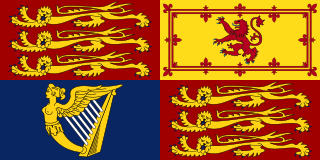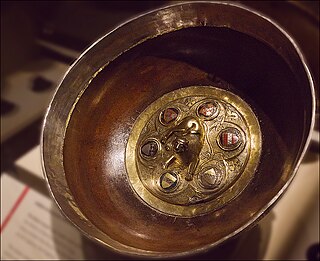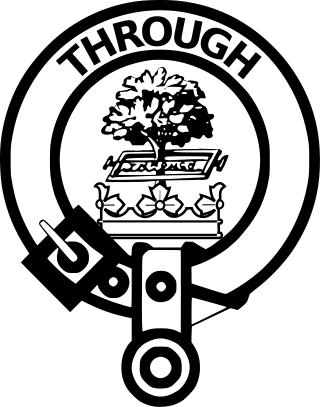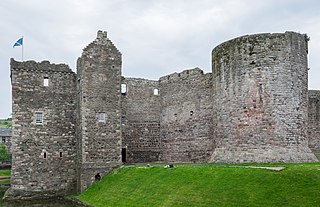
Duke of Rothesay is the main dynastic title traditionally given to the male heir apparent to the Scottish and, later, British thrones. The dukedom was created in 1398 by Robert III of Scotland for his eldest son.

The House of Stuart, originally spelled Stewart, was a royal house of Scotland, England, Ireland and later Great Britain. The family name comes from the office of High Steward of Scotland, which had been held by the family progenitor Walter fitz Alan. The name Stewart and variations had become established as a family name by the time of his grandson Walter Stewart. The first monarch of the Stewart line was Robert II, whose male-line descendants were kings and queens in Scotland from 1371, and of England, Ireland and Great Britain from 1603, until 1714. Mary, Queen of Scots, was brought up in France where she adopted the French spelling of the name Stuart.

The royal standard of the United Kingdom is the banner of arms of the monarch of the United Kingdom, currently Charles III. It consists of the monarch's coat of arms in flag form, and is made up of four quarters containing the arms of the former kingdoms of England, Ireland, and Scotland. There are two versions of the banner, one used in Scotland in which the Scottish quarters take precedence, and one used elsewhere in which the English quarters take precedence.

Rothesay is the principal town on the Isle of Bute, in the council area of Argyll and Bute, Scotland. It lies along the coast of the Firth of Clyde. It can be reached by ferry from Wemyss Bay, which offers an onward rail link to Glasgow. At the centre of the town is the 13th-century ruin Rothesay Castle, unique in Scotland for its circular plan.
The Isle of Bute, known as Bute, is an island in the Firth of Clyde in Scotland, United Kingdom. It is divided into highland and lowland areas by the Highland Boundary Fault.

A mazer is a special type of wooden drinking vessel, a wide cup or shallow bowl without handles, with a broad flat foot and a knob or boss in the centre of the inside, known technically as the "print" or "boss". Mazers vary from simple pieces all in wood to those ornamented with metalwork, often in silver or silver-gilt. They use dense impervious woods such as maple, beech and walnut. They represent a north European medieval tradition, and mostly date from the 11th to the 16th centuries.

The coat of arms of Scotland, colloquially called the Lion Rampant, is the coat of arms historically used as arms of dominion by the monarchs of the Kingdom of Scotland, and later used within the coat of arms of Great Britain and the present coat of arms of the United Kingdom. The arms consist of a red lion surrounded by a red double border decorated with fleurs-de-lis, all on a gold background. The blazon, or heraldic description, is: Or a lion rampant Gules armed and langued Azure within a double tressure flory-counter-flory of the second.

The coat of arms of Iceland displays a silver-edged, red cross on blue shield, alluding to the design of the flag of Iceland. It is the only national arms to feature four supporters: the four protectors of Iceland (landvættir) as described in Heimskringla, standing on a block of columnar basalt. The bull (Griðungur) is the protector of northwestern Iceland, the eagle or griffin (Gammur) protects northeastern Iceland, the dragon (Dreki) protects the southeastern part, and the rock-giant (Bergrisi) is the protector of southwestern Iceland. Great respect was given to these creatures of Iceland, so much that there was a law during the time of the Vikings that no ship should bear grimacing symbols when approaching Iceland. This was so the protectors would not be provoked unnecessarily.

The Royal Banner of the Royal Arms of Scotland, also known as the Royal Banner of Scotland, or more commonly the Lion Rampant of Scotland, and historically as the Royal Standard of Scotland, or Banner of the King of Scots, is the royal banner of Scotland, and historically, the royal standard of the Kingdom of Scotland. Used historically by the Scottish monarchs, the banner differs from Scotland's national flag, the Saltire, in that its official use is restricted by an Act of the Parliament of Scotland to only a few Great Officers of State who officially represent the Monarchy in Scotland. It is also used in an official capacity at royal residences in Scotland when the Head of State is not present.

The Clan Hamilton, or House of Hamilton, is a Scottish clan of the Scottish Lowlands.

Rothesay Castle is a ruined castle in Rothesay, the principal town on the Isle of Bute, in western Scotland. Located at NS086646, the castle has been described as "one of the most remarkable in Scotland", for its long history dating back to the beginning of the 13th century, and its unusual circular plan.

Alan fitz Walter was hereditary High Steward of Scotland and a crusader.
Patrick II (1185–1249), called "6th Earl of Dunbar", was a 13th-century Anglo-Scottish noble, and one of the leading figures during the reign of King Alexander II of Scotland.

Clan Stewart is a Scottish Highland and Lowland clan. The clan is recognised by Court of the Lord Lyon; however, it does not have a Clan Chief recognised by the Lord Lyon King of Arms. Because the clan has no chief it can be considered an armigerous clan; however, the Earls of Galloway are now considered to be the principal branch of this clan, and the crest and motto of The Earls of Galloway's arms are used in the Clan Stewart crest badge. The Court of the Lord Lyon recognises two other Stewart/Stuart clans, Clan Stuart of Bute and Clan Stewart of Appin. Clan Stuart of Bute is the only one of the three clans at present which has a recognised chief.
Sir Walter fitz Gilbert of Cadzow, 1st Laird (Lord) of Cadzow was a Scottish nobleman. The husband to Mary Gordon of Huntly, they wed in 1308 in Cadzcow, Lanarkshire, Scotland. He is the first historically confirmed progenitor of the House of Hamilton, which includes the Dukes of Hamilton, Dukes of Abercorn and Earls of Haddington.

Clan Stuart of Bute is a Highland Scottish Clan and is a branch of the larger Clan Stewart.

Sir John Arundell (1474–1545) Knight Banneret, of Lanherne, St Mawgan-in-Pyder, Cornwall, was "the most important man in the county", being Receiver-General of the Duchy of Cornwall. His monumental brass in the church at St Columb Major in Cornwall was described by Dunkin (1882) as "perhaps the most elaborate and interesting brass to be found in Cornwall".

The Coat of arms of the London Borough of Brent is the official arms of the London Borough of Brent. It was granted on 1 September 1965.

Friar Mark Hamilton was a Scottish Dominican and author of a History of the Hamiltons. His kinsman Regent Arran gave Friar Mark Hamilton £4 Scots for a friar's habit on 20 September 1553. Apart from his History and the record of the gift of a habit, few other details of Friar Mark's life are known.
James Gray was a Scottish goldsmith working in Edinburgh during the reigns of Mary, Queen of Scots and James VI of Scotland. Gray is known for the "Galloway mazer", a gilt cup now held by the National Museums of Scotland. He also engraved the brass plate for the tomb of Regent Moray in St Giles, Edinburgh.


















